Today, the Texas Centennial Commemorative Silver Half Dollar Coin remembers the Battle of San Jacinto, a short but deciding battle fought on April 21, 1836.
The Peterson Magazine of January 1896 included an article titled American Frontier Heroes, Sam Houston, written by George Allen Wright.
An excerpt:
=====
General Jackson had not forgotten the hero of Tohopeka, and had had some correspondence with him about a design Houston was reported to cherish of conquering Texas.
Many believe that the President actually encouraged Houston to undertake the liberation of Texas in order to add it eventually to the Union.
At any rate, when the American settlers in the Southwest raised the Lone Star in 1835, and drove out the Mexicans, Houston appeared among them as a leader.
He was probably the most famous Tennessean of his day except the President, and in the Southwest he was so much admired that there had been talk of sending a committee of Texans to invite him to come down to command the army.
All the world knows of the massacres perpetrated by the Mexicans under Santa Anna.
There were more than six thousand men in that great army which had come to teach a few hundred Anglo-Saxons the superiority of Spanish blood.
Unfortunately the forces of the patriots were scattered.
The Alamo was a fortification at San Antonio held by 145 men under Colonel Travis.
Colonel Fannin with 530 men was at Goliad, fifty miles to the southeast, and General Houston was at Gonzales, to the northward, with the main body of the army, estimated at one time to contain 1,400 men.
Orders were sent by General Houston to the other two commanders to fall back before Santa Anna and join the main body, where every available man was needed for one decisive contest.
But while the frontier breeds brave soldiers it also breeds independent ones.
A force of 6,000 Mexicans was nothing to 145 fire-eating Texans, shut up behind an eight-foot wall, with a powder magazine and a few bushels of corn.
Or perhaps the gallant little garrison in the Alamo never received the order to fall back.
They acquitted themselves like men. They fought and died— Davy Crockett, Colonel Bowie, and the rest—not a man was spared to tell the tale of one of the most glorious defenses in history.
Colonel Fannin’s little band had been depleted by two detachments of 30 and 100 men sent to assist the Texans holding the Alamo, and only sent to their own death.
With 400 men he began a late retreat, but was surrounded at the Coleta River, and after fighting all night surrendered.
The prisoners were escorted back to Goliad, and next morning, upon orders from Santa Anna, they were divided into three companies, led out of town in different directions, and shot down.
Such was the state of affairs when the cruel and victorious Mexican army approached General Houston’s little band, from which the fearful had deserted, leaving only about seven hundred souls—a veritable Gideon’s band.
For a month they retreated before the Mexican host, many companies of which were made up of convicts and other criminals.
Santa Anna had expected the Revolutionists to retreat; he had no fear of an attack from them.
He little dreamed that the one and only purpose of the Texan general was to secure the best fighting odds chance might afford, and then to strike for liberty or death.
The battle of San Jacinto was the making of Sam Houston.
It was fought April 21, 1836, at the mouth of the San Jacinto River.
Santa Anna was caught in a narrow tract of land between the Buffalo River and the marshes of San Jacinto Bay, with only 1,500 of his troops.
Although the Texans had been eager to begin the attack the night before, General Houston restrained them.
The battle began at 9 A.M., after the information had been passed along the line that the only bridge affording escape had been cut down.
Then with the cry “Remember the Alamo!” those 700 desperate men charged upon their foes.
“The Mexican army was drawn up in perfect order,” says Mr. Lester, “ready to receive the attack, and when the Texans were within about sixty paces, and before they had fired a rifle, a general flash was seen along the Mexican lines, and a storm of bullets went flying over the Texan army.
“They fired too high, but several balls struck General Houston’s horse in the breast, and one ball shattered the General’s ankle.
“The noble animal staggered for a moment, but Houston urged him on.”
The fate of Texas was decided within twenty minutes.
The battle of San Jacinto turned into a rout and a pursuit. The Texans, many of them, threw away their guns, and with swords and knives proceeded to “Remember the Alamo.”
Seven hundred Mexicans were slain and 700 taken prisoners.
Among the prisoners was Almonte, one of Santa Anna’s generals, and afterward Santa Anna himself was brought in.
The Texans lost only six killed and about twenty-five wounded.
General Houston, during a conversation with the prisoners, took an ear of common Indian corn out of his pocket: “You will never conquer soldiers who thrive on such rations as this,” he said.
It had been his only diet for several days.
=====
The Texas Centennial Commemorative Silver Half Dollar Coin shows with an artist’s portrayal of Sam Houston.
